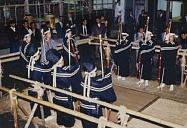

Total:35items
- Folk Performing Art (16)
- Kenbai: Sword Dance
- Kirin Shishimai: Kylin Lion Dance
- Yoshiwa Taiko Odori: Yoshiwa Drum Dance
- Omiya Odori: Omiya Dance
- Tsurusaki-Odori festival
- Omi Take-no-karakai (Tug-of-wars with bamboo)
- Nakizumo: Crying Baby Sumo
- Ryugasaki Tsukumai:Ryugasaki Acrobatic Performance
- Mikawa Manzai
- Esashi Oiwake: Esashi Folk Singing
- Ayado Yonenbutsu and Bon festival dance
- Occhi-no-Ohinagayu (rice porridge offering for the Doll's Festival in Occhi)
- Hanatori-odori Dance (Masuda area)
- Kaga-manzai
- Rice Planting festival of Tsutsukowake Shrine
- Edo sato kagura: Edo folk dance for entertaining god
- Kabuki (2)
- Noh & Kyogen (1)
- Festival (10)
- Ritual & Ceremony (2)
- Puppet Play (2)
- Folk technology (2)

 |
|
《Feature》
Daimokutate is a perfoming art with a theme based on the military commander Genpei. The performers take partial charge of the lines per the characters of the story and narrates with a unique intonation. It is performed by the young boys in Kamifukawa who are mainly seventeen years old. In Kamifukawa, there is a custom that when a young boy turns seventeen years old, he becomes a member of the shrine's traditional religious rites (miyaza). It has been commonly regarded that the boy is acknowledged as an adult member in the local community by joining this organization. As Daimokutate is an offering of entertainment to the patron god performed by those young people, it is also meant to be a ritual to become an adult. Often the number of performers is not enough as they are only seventeen years old, therefore, people who are a little older join to perform together.
In Kamifukawa there are three verses that have been passed down, "Itsukushima," "Daibutsukuyou," and "Ishibashiyama." Out of the three verses either "Itsukushima" or "Daibutsukuyo" is usually performed. "Itsukushima" is done by eight people and "Daibutsukuyo" is by nine. Also, when Yahashira shrine is rebuilt or repaired (called "zooku"), it is customary to perform the "Itsukushima" verse for three years as an offering, starting from the year of "zooku."
On the eve of the Yoimiya Festival, the performers leave Ganyakuji,their dressing room, at the west of the shrine. Being led by the elders the performers sing "Michibiki" and head to the main shrine where a stage is set in front of the Sanrojo. The performers, in Sou robe and a Tateeboshi hat with a fan inserted at the collar and a bow in hand (there may be a slight difference depending on the role of the character), take their respective positions on stage. The summoner at the Sanrojo calls out "Ichiban Kiyomori"which is the line order and the character's name. The performer responds to this with a distinct intonation, stating "Wareware wa kore (I am so forth)" or "Somo somo kore wa (In the first place I am)" to identify who he is and then continues his lines.
There is a scene in "Itsukushima" where Kiyomori is given a partisana pole sword from Bensaiten. Basicaly, there is almost no acting but the actors calmly continue to narrate the story in their respective places. This way of narration is the main characteristic of daimokutate. Towards the end of the verse "Fusho Mai" is danced. While all the actors sing "Yorokobi uta," the main performer comes forward to the center of the stage. He raises his fan with his head thrown back and goes round the stage, stepping with all his might. It is a short dance but is an impressive action, changing suddenly the whole atmosphere which was quiet before. In the end, all the performers sing "Hameku" and leave the stage, led once again by the elders, singing "Michibiki."
It is not certain as to when daimokutate began. In Mugenki of "Tamonin nikki" a diary written by the Buddhist priest of Koufukuji temple in 1576 (year four of Tensho period), it is written that "Daimokutate tote inaka no Miya utsushino toki, mukashino nani no idetatsu nite nanoru." Also, a part of verse dated from the end of the 16th century to early 17th century remains at the Nyucho Shrine (Nyucho, Nara city) near Kamifukawa. Furthermore, it is noted in a diary of a low-status farmer without land from Tawara area of Nara city that daimokutate was performed in Minedera temple and Matono of Yamazoe Village in 1692 (year five of Genroku period) and 1706 (year three of Houei). In Kamifukawa, a book of verses written first in 1624 (the first year of Kanei) remains. This book was rewritten in 1733 (year 18 of Kyouhou) which shows that daimokutate was performed in this area from early in the Azuchi Momoyama/Edo periods. As for the naming of daimokutate, "Nippojisho" published in 1603 explains that "daimoku" means "nawoarawasu"(introducing one's name), so assumingly the name may have been originated by performers'introducing his name followed by narrating the story.
[Designated as a significant intangible folk cultural asset of Japan ]
Provided by: Nara City Hall Educational Affairs Department Cultural Assets Division
Translation: Yoshiko Nagao, reviewed by Hiroko Okamura
Daimokutate is a perfoming art with a theme based on the military commander Genpei. The performers take partial charge of the lines per the characters of the story and narrates with a unique intonation. It is performed by the young boys in Kamifukawa who are mainly seventeen years old. In Kamifukawa, there is a custom that when a young boy turns seventeen years old, he becomes a member of the shrine's traditional religious rites (miyaza). It has been commonly regarded that the boy is acknowledged as an adult member in the local community by joining this organization. As Daimokutate is an offering of entertainment to the patron god performed by those young people, it is also meant to be a ritual to become an adult. Often the number of performers is not enough as they are only seventeen years old, therefore, people who are a little older join to perform together.
In Kamifukawa there are three verses that have been passed down, "Itsukushima," "Daibutsukuyou," and "Ishibashiyama." Out of the three verses either "Itsukushima" or "Daibutsukuyo" is usually performed. "Itsukushima" is done by eight people and "Daibutsukuyo" is by nine. Also, when Yahashira shrine is rebuilt or repaired (called "zooku"), it is customary to perform the "Itsukushima" verse for three years as an offering, starting from the year of "zooku."
On the eve of the Yoimiya Festival, the performers leave Ganyakuji,their dressing room, at the west of the shrine. Being led by the elders the performers sing "Michibiki" and head to the main shrine where a stage is set in front of the Sanrojo. The performers, in Sou robe and a Tateeboshi hat with a fan inserted at the collar and a bow in hand (there may be a slight difference depending on the role of the character), take their respective positions on stage. The summoner at the Sanrojo calls out "Ichiban Kiyomori"which is the line order and the character's name. The performer responds to this with a distinct intonation, stating "Wareware wa kore (I am so forth)" or "Somo somo kore wa (In the first place I am)" to identify who he is and then continues his lines.
There is a scene in "Itsukushima" where Kiyomori is given a partisana pole sword from Bensaiten. Basicaly, there is almost no acting but the actors calmly continue to narrate the story in their respective places. This way of narration is the main characteristic of daimokutate. Towards the end of the verse "Fusho Mai" is danced. While all the actors sing "Yorokobi uta," the main performer comes forward to the center of the stage. He raises his fan with his head thrown back and goes round the stage, stepping with all his might. It is a short dance but is an impressive action, changing suddenly the whole atmosphere which was quiet before. In the end, all the performers sing "Hameku" and leave the stage, led once again by the elders, singing "Michibiki."
It is not certain as to when daimokutate began. In Mugenki of "Tamonin nikki" a diary written by the Buddhist priest of Koufukuji temple in 1576 (year four of Tensho period), it is written that "Daimokutate tote inaka no Miya utsushino toki, mukashino nani no idetatsu nite nanoru." Also, a part of verse dated from the end of the 16th century to early 17th century remains at the Nyucho Shrine (Nyucho, Nara city) near Kamifukawa. Furthermore, it is noted in a diary of a low-status farmer without land from Tawara area of Nara city that daimokutate was performed in Minedera temple and Matono of Yamazoe Village in 1692 (year five of Genroku period) and 1706 (year three of Houei). In Kamifukawa, a book of verses written first in 1624 (the first year of Kanei) remains. This book was rewritten in 1733 (year 18 of Kyouhou) which shows that daimokutate was performed in this area from early in the Azuchi Momoyama/Edo periods. As for the naming of daimokutate, "Nippojisho" published in 1603 explains that "daimoku" means "nawoarawasu"(introducing one's name), so assumingly the name may have been originated by performers'introducing his name followed by narrating the story.
[Designated as a significant intangible folk cultural asset of Japan ]
Provided by: Nara City Hall Educational Affairs Department Cultural Assets Division
Translation: Yoshiko Nagao, reviewed by Hiroko Okamura
| City/Town | Kamifukawa cho, Nara City, Nara Pref. |
|---|---|
| Location | Kamifukawa cho/Yahashira shrine's autumn festival
Date: October 12th |
| Contact | Educational Affairs Department Cultural Assets Division
Tel +81(0)742-34-5369 / Fax +81(0)742-34-4859 (Japanese only) Assistance needed? For inquiries in English: JTCO Contact Form Your inquiries will be forwarded by JTCO in Japanese to the organization you wish to contact. |
| Access | Take a bus for Kokudo-Yamazoe/Ueno, Get off at Kokudo-Ogura and walk for 40 minutes |
| Highlight/POI | In this performance, the roles of the performers are fixed, stage setting and hand props are simple, no costumes are worn, acting is limited, and each performer speaks his lines at the respective place on the stage. This is recognized by performing-art history researchers as "succeeding the early form of adapting story-telling for the stage"and is highly rated as the one reminding the public entertainment of the Medieval Period of Japan. Nowadays daimokutate has been handed down only in Kamifukawa which also makes it valuable. In addition, the important characteristic of this folk entertainment is that it remain as an offering to the patron god, not as an entertainment for audience, meant to be a ritual for young people who become adults, and that a performance is done with the support from the local community. |



